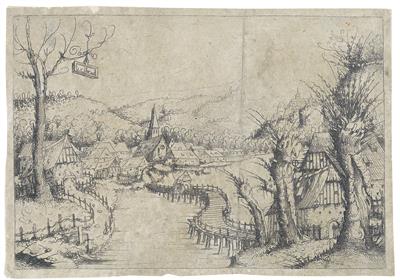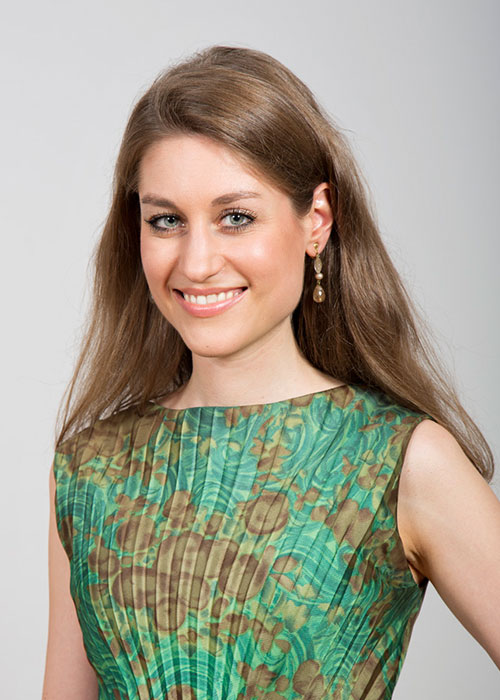Augustin Hirschvogel

(Nuremberg 1503-1553 Vienna) Landscape with a wining wooden Bridge, a village in the background Hintergrund ein Dorf, 1546, etching, on laid paper, monogrammed and dated "AHF 1546" in the plate, 13,8 x 20 cm, with narrow margins around framing lines, a crease and a tear through sheet, foxing, Bartsch 76, Hollstein 48, mounted, unframed, (Sch)
Augustin Hirschvogel (1503-1553) derived from a family of stained-glass painters in Nuremberg and was a member of his father’s workshop until 1525. After his father’s death he established a pottery workshop in his home town and executed earthenware and vessels after Italian and mainly Venetian models. In addition he built up a reputation as a cutter of heraldic items and coat-of-arms. He was a cartographer for Emperor Ferdinand I in the late 1530s as well. The Emperor assigned him with the exceution of a map of Austria in 1541 (which was cut in wood by Joh.Weigel in Nuremberg) and of Carinthia and Krain (edited in the Atlas by Abraham Örtel) in 1544. By 1543 Hirschvogel had established contacts with the imperial court in Vienna, where he settled in 1544.
There he was engaged as cartographer, etcher and stained-glass painter. In this time he seems to have dedicated himself to etching. He designed and executed several portraits, coat-of-arms, ornaments and designs for all kinds of vessels. Above all he created landscape prints.
Hirschvogel was one of the first etchers in Germany to make regular use of copper plates and created landscape etchings without religious or allegorical content. Thus landscape became the primary motif in etching from its beginning onwards far into the 19th century.
Only few landscape etchings by Hirschvogel have survived. They appear rarely on the art market. They are based on etched plates which in certain areas were retouched with the chisel; most of them are monogrammed A(ugustin) H(irsch) F(ogel) and dated. His delicate stroke, however, permitted only few impressions from one plate. Hollsteins (New Hollstein, German engravings, etchings and woodcuts, c. 1400-1700) lists just some twenty impressions and three counter-proofs of the present etching.
Esperta: Mag. Astrid-Christina Schierz
 Mag. Astrid-Christina Schierz
Mag. Astrid-Christina Schierz
+43-1-515 60-546
astrid.schierz@dorotheum.at
24.10.2013 - 17:00
- Prezzo realizzato: **
-
EUR 6.250,-
- Stima:
-
EUR 5.000,- a EUR 7.000,-
Augustin Hirschvogel
(Nuremberg 1503-1553 Vienna) Landscape with a wining wooden Bridge, a village in the background Hintergrund ein Dorf, 1546, etching, on laid paper, monogrammed and dated "AHF 1546" in the plate, 13,8 x 20 cm, with narrow margins around framing lines, a crease and a tear through sheet, foxing, Bartsch 76, Hollstein 48, mounted, unframed, (Sch)
Augustin Hirschvogel (1503-1553) derived from a family of stained-glass painters in Nuremberg and was a member of his father’s workshop until 1525. After his father’s death he established a pottery workshop in his home town and executed earthenware and vessels after Italian and mainly Venetian models. In addition he built up a reputation as a cutter of heraldic items and coat-of-arms. He was a cartographer for Emperor Ferdinand I in the late 1530s as well. The Emperor assigned him with the exceution of a map of Austria in 1541 (which was cut in wood by Joh.Weigel in Nuremberg) and of Carinthia and Krain (edited in the Atlas by Abraham Örtel) in 1544. By 1543 Hirschvogel had established contacts with the imperial court in Vienna, where he settled in 1544.
There he was engaged as cartographer, etcher and stained-glass painter. In this time he seems to have dedicated himself to etching. He designed and executed several portraits, coat-of-arms, ornaments and designs for all kinds of vessels. Above all he created landscape prints.
Hirschvogel was one of the first etchers in Germany to make regular use of copper plates and created landscape etchings without religious or allegorical content. Thus landscape became the primary motif in etching from its beginning onwards far into the 19th century.
Only few landscape etchings by Hirschvogel have survived. They appear rarely on the art market. They are based on etched plates which in certain areas were retouched with the chisel; most of them are monogrammed A(ugustin) H(irsch) F(ogel) and dated. His delicate stroke, however, permitted only few impressions from one plate. Hollsteins (New Hollstein, German engravings, etchings and woodcuts, c. 1400-1700) lists just some twenty impressions and three counter-proofs of the present etching.
Esperta: Mag. Astrid-Christina Schierz
 Mag. Astrid-Christina Schierz
Mag. Astrid-Christina Schierz
+43-1-515 60-546
astrid.schierz@dorotheum.at
|
Hotline dell'acquirente
lun-ven: 10.00 - 17.00
kundendienst@dorotheum.at +43 1 515 60 200 |
| Asta: | Disegni e stampe fino al 1900, acquarelli e miniature |
| Tipo d'asta: | Asta in sala |
| Data: | 24.10.2013 - 17:00 |
| Luogo dell'asta: | Wien | Palais Dorotheum |
| Esposizione: | 19.10. - 24.10.2013 |
** Prezzo d'acquisto comprensivo di tassa di vendita e IVA
Non è più possibile effettuare un ordine di acquisto su Internet. L'asta è in preparazione o è già stata eseguita.
